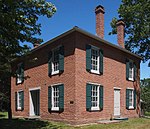Nine Mile Creek (Minnesota River tributary)
Minnesota river stubsRivers of Hennepin County, MinnesotaRivers of MinnesotaTwin Cities, Minnesota geography stubs
Nine Mile Creek is a stream in Hennepin County, Minnesota, in the United States. It is a tributary of the Minnesota River. Nine Mile Creek was named from its distance, nine miles (14 km) southwest of Fort Snelling where it crosses the (Old) Shakopee Road.
Excerpt from the Wikipedia article Nine Mile Creek (Minnesota River tributary) (License: CC BY-SA 3.0, Authors).Nine Mile Creek (Minnesota River tributary)
Minnesota River Bottoms Singletrack Trail,
Geographical coordinates (GPS) Address Nearby Places Show on map
Geographical coordinates (GPS)
| Latitude | Longitude |
|---|---|
| N 44.800555555556 ° | E -93.290277777778 ° |
Address
Minnesota River Bottoms Singletrack Trail
Minnesota River Bottoms Singletrack Trail
55337
Minnesota, United States
Open on Google Maps









